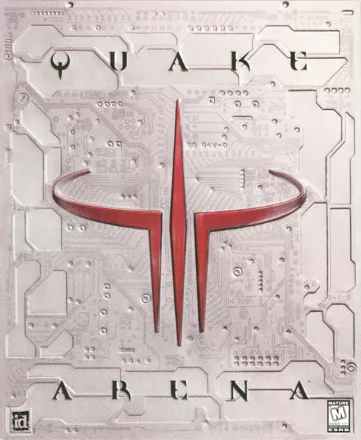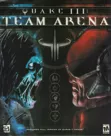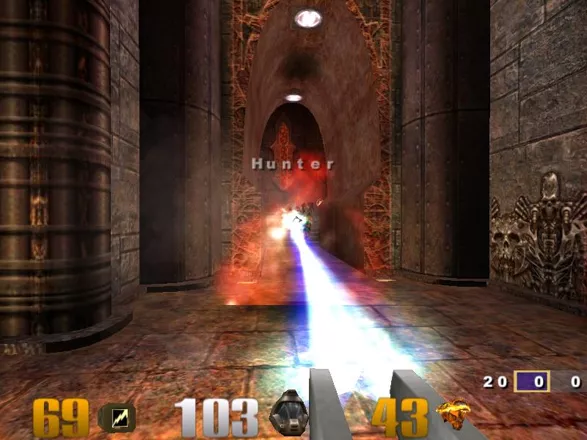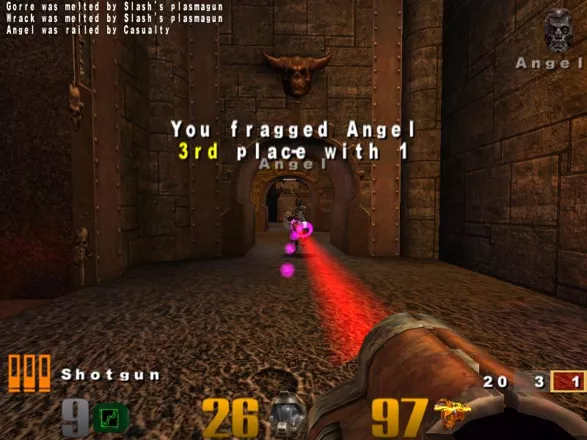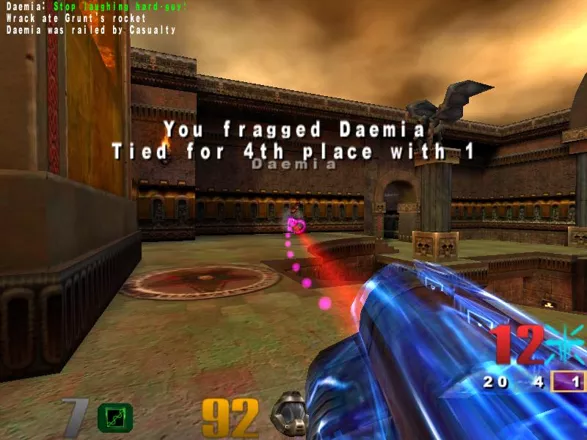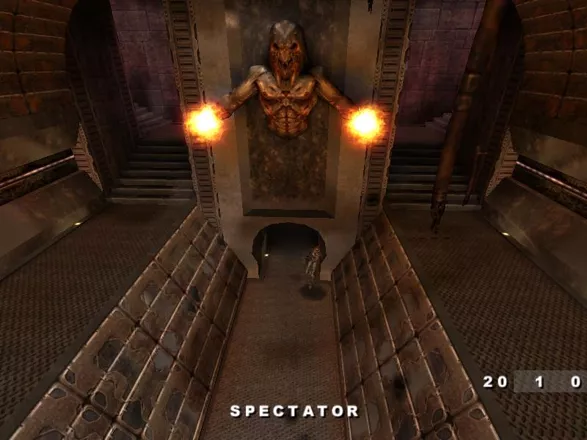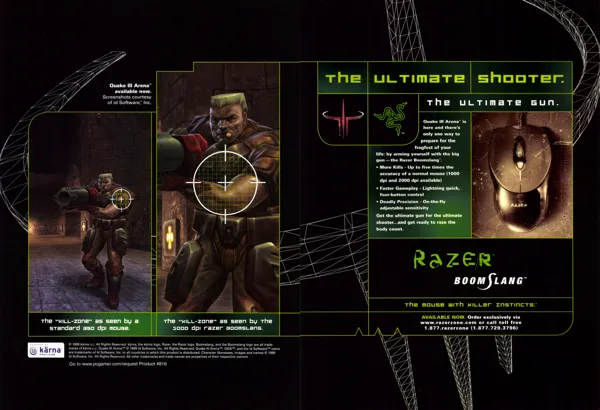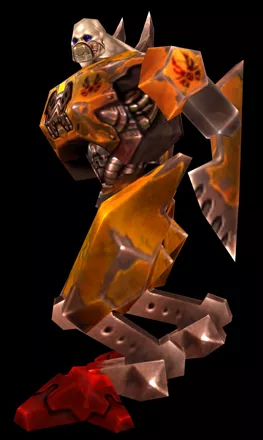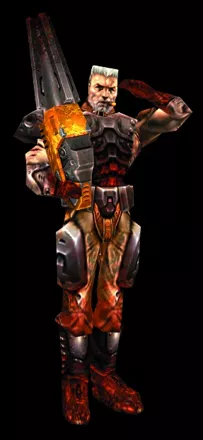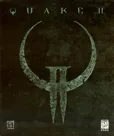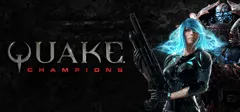Quake III: Arena
Description official descriptions
The third game in the Quake series is a departure from the previous games, focusing exclusively on multiplayer arena fighting with no story-driven singleplayer part - directly competing with Epic Games that did the same with the contemporary Unreal Tournament.
The offline part takes the player through a number of one-on-one and team-based challenges against AI-controlled opponents, slowly ranking upwards in difficulty, as the character of the player's choosing. Compared to the previous titles, the colours and general design of the game are much brighter and it shakes off the dominant shades of brown and grey the previous titles in the series were known for. The player's arsenal consists of new and familiar, but redesigned weapons, including a gauntlet (melee attacks) and a machine gun as the spawn weapons, a shotgun, plasma gun, lightning gun, rocket launcher, railgun, and BFG. Each weapon has specific advantages, ranging from the amount of damage to reloading times and the ability to hit-scan opponents.
The different arenas are also filled with health bubbles, complete sets of armour and armour shards, the well-known Quad Damage power-up, ammunition, and specials such as Mega Health, Haste, Invisibility, a powerful Battlesuit, and more. As with the other Quake games, it is known for its freedom in movement. Advanced players use techniques such as rocket jumping, strafing, and circle jumping to quickly get around areas. The game offers more speed than Quake II, but it is not as fast as the original Quake. Not everything was kept - the double-jumping from the previous titles was removed for instance, but replaced with new tricks.
The single-player part only serves as a diversion for the online multiplayer options, with modes such as duel, team deathmatch (TDM), capture the flag (CTF), and more. As with Quake II, the vanilla version of the game was eventually heavily tweaked by the players' community with all-new tournament features (including voting, referees, banning, netcode updates), as it was used in professional Pro Gaming tournaments for almost ten years.
The only difference between Quake III: Arena and the limited Elite Edition is the tin box packaging.
Spellings
- 雷神之锤III:竞技场 - Simplified Chinese spelling
Groups +
- 3D Engine: id Tech 3 (Quake III: Arena)
- Anti-Cheat Technology: PunkBuster
- BPjS / BPjM indexed games
- Game feature: In-game screenshot capture
- Gameplay feature: Drowning
- Gameplay feature: Recordable replays
- Games referenced in movies
- Games with Dopefish
- Games with downloadable official map/level editors
- Games with official modding tools
- Games with officially released source code
- Genre: Arena shooter
- Protagonist: Female (option)
- Quake series
- Technology: amBX
Screenshots
Promos
Videos
Add Trailer or Gameplay Video +1 point
See any errors or missing info for this game?
You can submit a correction, contribute trivia, add to a game group, add a related site or alternate title.
Credits (Linux version)
54 People (53 developers, 1 thanks) · View all
| Programming | |
| Art | |
| Game Designer | |
| Level Design | |
| CEO | |
| Director of Business Development | |
| Biz Assist and id Mom | |
| Special Thanks to | |
| Bot AI | |
| Menu Interface |
|
| CTF | |
| Linux Conversion | |
| Map Editor | |
| GL Setup | |
| Additional Programming | |
| Additional Level Design | |
| Quake III Arena music |
|
| [ full credits ] | |
Reviews
Critics
Average score: 88% (based on 70 ratings)
Players
Average score: 3.9 out of 5 (based on 261 ratings with 12 reviews)
The Good
The concept was clever. I admired Id's boldness in making a multiplayer-only game. Previous games in the Quake series had been criticised for their bland single-player experience, and it was brave of Id to damn the torpedoes and put their sterling silver in one basket. Especially here in the UK, where we lagged behind the Americans by a couple of years; broadband has only recently become the mainstream.
It was doubly bold of Id to ignore the obvious gap in the market for a single-player Quake III, given that Quake II had sold well and that the obvious competition - Unreal - was also going the multiplayer-only route. So, three cheers to Id for being bold. It worked, too. Quake III was a substantial hit that spawned a little galaxy of spin-offs. It appealed to me as much as black pudding, but I admired it nonetheless.
But what about the game itself? Quake III is very attractive. It follows the same visual path as Quake II, in that it is colourful and cartoonish. There was a lot of hype at the time about curved arches and glowing lights etc, and although it is not the technical breakthrough of its predecessors, the visual style hasn't really dated today.
The intro movie was short but fantastic. If only the Doom film had been done in the same style.
The Bad
I can think of few more unpleasant things than teenagers. I certainly don't want to spend time playing computer games with them. With this in mind I am uninterested in Quake III's multiplayer game. I was similarly uninterested in Unreal: Tournament as a multiplayer title, but I enjoyed it immensely because it looked fantastic and the computer opponents were enjoyable. They ranged from stupid cannon fodder to absolute fiends, but they seemed alive. Sometimes I felt that I could even put down my weapon and negotiate with them. The sniper rifle was wonderful. I loved to shoot off their heads.
Quake III reminded me of another multiplayer-only title, X-Wing Vs TIE Fighter. In the latter game the AI was duff, in that it was entirely robotic. The enemy spacecraft were uniformly perfect shots and were only there to fill out the numbers. They did not miss. They could, superhumanly, tell where you were pointing your crosshairs and where you were going. They could track you and lead and nail you like the fire control software in an F-14 jet fighter. Six targets at once, from a range of two hundred miles. I felt as if I was the navigator of a Russian bomber, contemplating the incoming missiles, unable to dodge or bail out. It was not pleasant.
Quake III is not nearly as bad as all that, but the AI is nonetheless too obviously computerised, in the sense that it is a perfect shot that has been degraded with some clever code. It quickly becomes impossible to suspend disbelief and imagine that you are playing against another person. This can be alleviated by lowering the difficulty level, but that smacks of failure.
Some people will argue that I am simply a very poor gamesplayer, and that I am old and have lost my touch. This is the kind of argument a teenager might use, and it is one of the reasons why I have come to detest teenagers. It is a conservative argument. An argument that stems from a desire not to lose face in front of one's peers by admitting weakness. It is the kind of argument that ends up with a drunken child trying to walk along a wall, and falling off and breaking his neck.
Unreal: Tournament is the more complex game; there are far more modes of play and you can customise the environment and the effects that weapons have upon it. I assume that there are mods and patches to allow this in Quake III as well, but by 1999 I had begun to grow past the age of caring and I care less in 2006.
The Bottom Line
Most reviews compared Quake III with Unreal: Tournament, and so did mine. There were partisans on both sides, all of seven years ago. The general consensus amongst teenage gamesplayers who I detest was that Quake III was a manly game for manly men, whereas Unreal: Tournament was a limp-wristed game for men who were not manly.
Nonetheless I prefer the latter game. Quake III is more obviously a multi-player engine with bare support for single-play, whereas Unreal: Tournament had more thought put into the single-player experience. Quake III might well be the bee's knees as a multiplayer game. As a single-player game I quickly became bored with it.
Windows · by Ashley Pomeroy (225) · 2006
A worthy successor to the original Quake fragfest
The Good
While it features virtually no story, however the main focus of the game was to make up for Quake 2's slow multiplayer which alienated most Quake players. This is not to say bots in single-player are not challenging... just that this game really shines in online or LAN multiplayer. Its deathmatch experience is the next best thing since Doom and Quake. Extremely fast gameplay, intense action, balanced weapons. expert level design, beautiful models and Carmack's once again unbelievably good graphics engine were the hallmarks of its resounding success. The only game that could slow the Quake frenzy was Counter-Strike.
The Bad
The single player part was probably its weakest part, however I found the bots to be quite entertaining on their own. A worthy substitute when fragging offline. Some opponents in certain stages were probably more lethal than their skill level should allow.
The Bottom Line
Speed, Power and Adrenaline. One of the best multiplayer experiences ever. An incredibly powerful and modable graphics engine that stood the test of time and was used even as recently as 2003.
Windows · by Silverblade (1382) · 2004
Awesome deathmatch redeems this meatless meal
The Good
In 1999, id Software did something that, depending on who you ask, was genius or stupidity: release an FPS game that almost completely eschewed single player gameplay and focused on multiplayer. Released side-by-side with Epic's Unreal Tournament, it became a cult FPS and is regarded by many as id's magnum opus. Which is surprising when you consider that Quake 3 is less of a game than any of its predecessors.
Quake 3 condenses the FPS genre into the simplest form possible. Realism, story, and design have all been given the shaft and what is left is nothing more than the raw basics of the genre. You pick up weapons, pick up ammo, and try to kill your enemies more times than they kill you. Doom is rocket science next to this. Predictably the game was the subject of a lot of backbiting and criticism, and many claimed it typified the style over substance trend gaming had gotten into. But I'm willing to forgive Quake 3 simply because it was the most fun deathmatch game of its time when released, and even today more than holds its own.
The core of the game, deathmatch mode, is a blast. The transparent pick-up-and-play design to it that makes it very easy to get into, and whether you're a novice or a pro there's something for everyone. Everything in the game is just right. Your characters move at just the right speed, the weapons are all perfectly balanced (for the first time in history, we get a default weapon that is not a total piece of crap), the powerups complement the gameplay perfectly, and in another first for id Software the maps that come with the game actually do not suck. I'm sure all veteran deathmatchers have horror stories about the terrible Quake maps, but Q3A's maps are almost flawless, speaking of endless playtesting and tweaking on the parts of the level designers. No longer does the first person to find the rocket launcher win, and no longer can you rack +20 frags by camping. "The Longest Yard" in particular must be one of the most fun and well-rounded FPS deathmatch maps ever.
The game becomes drastically different depending on how many players there are. If it's just you and a friend the game is a tense affair filled with stalking and stealth. If you've got sixteen players the game becomes a crazy mosh pit where you're frantically shooting non-stop at everything. Just about everything is user-configurable allowing for weird situations where every bullet kills or where players can only move at a snail's pace.
While Quake III Arena's focus may be its multiplayer deathmatch component, it does have a single-player mode. When playing alone, you can go up against artificial intelligence-controlled bots. The bots do their best to act like human players, and while I won't say they have the greatest AI ever they still put up a good fight. Each bot has different characteristics that govern the way it fights. The portly biker chick Lucy tends to duck a lot. Xaero, a Zen master and the final boss of the single-player mode, is also master of the railgun. There's also a tournament mode where you duel with increasingly tougher bots.
id Software's calling card has always been their boundary-pushing graphical engines, from the EGA graphics on Commander Keen to the realistic 3D environments of Quake I and II. With Quake III Arena they upped the ante yet again, delivering every cutting-edge effect in the book from volumetric lighting to curved surfaces, allowing the map designers freedom to create environments that go from hard edged industrial to squishy organic, all with geometric detail that is impressive even by today's standards.
And like all of the Quake games, it was built from the ground up to be user-modifiable. This spawned a lively modding scene that remains active to this day, tweaking the game's extremely flexible engine to produce everything from unofficial patches to completely new games. id Software actively supported this by releasing the source code and all their early design docs. That's one thing you can say about them, you never feel like a criminal when you're messing around with their games.
And I love the industrial metal soundtrack Sonic Mayhem did for the game. Seriously, I've got it on CD.
The Bad
Quake 3 is unapologetically a one-trick pony. It's about deathmatch, deathmatch, and deathmatch. Outstanding deathmatch perhaps, but once you're sick of deathmatch there's nothing else here.
This is not a criticism that can be applied universally across the genre. Unreal Tournament had a wide variety of multiplayer modes, including capture the flag, domination, and many others. There are people who spend as long learning to play Counter Strike as a grandmaster does learning chess. Even games like Duke Nukem 3D and Blood have combined great multiplayer modes with compelling single-player components.
Or look at it this way. Relatively few people play vanilla Quake 3 any more. It's all about mods like Rocket Arena and Urban Terror. In terms of replay value Quake 3 doesn't go the distance.
And on a less significant note Quake 3's in-built game browser doesn't really work properly and often will refuse connections. GameSpy Arcade is your best bet when looking for games on the internet. It's sad when GameSpy is the lesser of two evils.
The Bottom Line
I could roast Quake 3 all day long for being unoriginal, derivative, etc and to be honest there's fairness in those criticisms. But in the end, you've got to review the game on its own terms. Quake 3 was made so new players could jump right in. It was made so long-time Quake fans wouldn't be too unfamiliar. It was made for people with short attention spans. Maybe it's a repugnant design philosophy but complaining about Quake 3 because it's retarded is like complaining about ice cream because it melts. With Quake 3 you've got an arcade game in a 3D-accelerated engine, and we've all got to accept that and move on.
For what it's worth, you'll have trouble finding a higher-quality multiplayer FPS anywhere. In movie jargon, Quake 3 "works".
Windows · by Maw (832) · 2007
Trivia
1001 Video Games
The PC version of Quake III Arena appears in the book 1001 Video Games You Must Play Before You Die by General Editor Tony Mott.
Copy protection
As Half-Life, the game shipped with a very controversial multiplayer CD key check. (The key was printed on the case of the CD-ROM)
This system reduced piracy, but also introduced several other interesting issues. Several people who had bought the game were unable to play it online because their cd-key had already been "stolen" by people who used key generator programs to find valid multiplayer keys. There are also numerous reports of Quake III: Arena boxes being opened at the store by dishonest people wanting to get a valid CD key.
Credits
After finishing the game, watch the credits roll. After the Credits show "THE END", the character with the hoverskates will skate around the screen like she's just learning.
Cut content
Quake III: Arena had several graphical features cut (assumed for performance reasons, and the arcane OpenGL ICD driver implementations at the time). Quake II-style particles and realistic flares (that occlude behind models and alpha textures) were present in earlier revisions, but did not make it to the final release of the game.
There was also a flamethrower weapon planned, as well as a 3-tier player class system (light, medium, heavy) which were also cut from the design. References to this can still be seen in older Q3Test releases, and the files of the designer player models in a patches' pak2.pk3 (the 1998 dated .skin files).
Engine
Some of the features of the id Tech 3 engine:
- Bump mapping instead of mip mapping: Mip mapping rescaled a texture for several different sizes. Bump mapping actually applies per pixel light calculation for each texture. The trade off is processor speed vs realistic lighting.
- Curved surfaces: Quake III will interpolate the position of a point by doing real time calculation, based on the curvature of a surface.
German index
On January 12, 2000, Quake III: Arena was put on the infamous German index by the BPjS (confirmed on March 31, 2000). For more information about what this means and to see a list of games sharing the same fate, take a look here: BPjS/BPjM indexed games.
Limited Edition
There was a Limited Edition run of a "tin" game box instead of cardboard. The only difference is the box itself, nothing else extra is included.
Multiplayer
- A downloadable add-on map pack is available on many Quake III: Arena sites on the internet, which contains all the maps from the Dreamcast release of the game. This add-on pack allows players of the Windows/Linux version to play on servers with Dreamcast players. This makes Quake III: Arena one of the first games to support transparent Internet play between a game console and the PC!
- In an interview on Gamasutra, designer Tim Willits called Quake III his biggest failure: "The game offered perfect multiplayer for hardcore players. In fact, they're still playing it. But the more casual gamers, and other people who actually have money, found playing next to impossible." This hints at a commercial motivation, and not the quality of the game itself.
References
- Quake III: Arena presents some of the heroes from previous Id games as playable skins, including the Space Marine from DOOM, the marine from Quake, and a few of the different marines from Quake II. All of these models and skins have both male and female counterparts, and different color variations.
- The game contains a reference to a popular online comic called User Friendly (www.userfriendly.org). When playing on q3dm19, pick up the fly power-up from the top of the level and fly all the way down until you’re below the final platform. Look up at the central floor and you’ll see an image of the Dust Puppy, as featured in the comic.
- While this game was in development, it was referred to as Trinity. This was an obvious reference that it was using the third and possibly final Quake engine.
- Some maps in Quake III: Arena include a wall decoration, that is actually The Icon of Sin, the final boss of id Software's Doom II: Hell on Earth.
- On the map q3dm15, the severed head of John Carmack can be found lying in a pool of blood.
References to the game
The game appears in the fifth episode of the first season of the US HBO TV series Six Feet Under. The character Claire is shown playing it, doing rail shots with the quad damage activated.
Sales
50,000 copies of the game were sold within the first 3 days of its release.
Source code release
On August 19th, 2005, the full (GPL'd) source code to the game was released.
Tech demo
id Software released a technology demo of the game, called Q3Test, in early 1999. In the following five days, 2 million internet games were started worldwide. That works out to around 4 games every second.
Awards
- GameSpy
- 1999 – Outstanding Graphics Award (together with Nocturne and The Wheel of Time)
- GameStar (Germany)
- Issue 03/2000 - Best Graphics in 1999
- Power Play
- Issue 02/2000 – Best Graphics in 1999
Information also contributed by Chris Martin, Cochonou, Jason Musgrave, JubalHarshaw, Lord FlatHead, leileilol, lethal guitar, Medicine Man, Paul Budd, Sciere, Scott Monster, Tibes80 and Xoleras
Analytics
Upgrade to MobyPro to view research rankings!
Related Sites +
-
Bill Brown - Music Composer (cinematics)
Listen to streaming and downloadable MP3 music tracks from this title at the composer's official site. -
PlanetQuake
PlanetQuake was one of the first sites featuring news and file about Quake 1, and it is now probably the biggest Quake series related site. If you can't find what you want there, you probably won't find it elsewhere. -
Quake III Forever
Play Quake III in your browser (Shockwave needed), courtesy of Necromanthus. -
Quake III: Arena
Official page on id Software's website -
Telefragged
A very huge site dedicated to the first person shooter games, particularly focused on the Quake series. -
The Final Hours of Quake III Arena
GameSpot writes about the end of Q3A development in their "Behind the Games" series.
Identifiers +
Contribute
Are you familiar with this game? Help document and preserve this entry in video game history! If your contribution is approved, you will earn points and be credited as a contributor.
Contributors to this Entry
Game added by DarkTalon.
Macintosh added by Corn Popper. Windows Apps added by Kam1Kaz3NL77. Dreamcast added by Adam Baratz.
Additional contributors: Cochonou, Istari, Eric Barbara, Adam Baratz, Unicorn Lynx, AdminBB, Sciere, Alaka, leilei, Patrick Bregger, Titan10, FatherJack.
Game added January 2, 2000. Last modified April 4, 2024.
